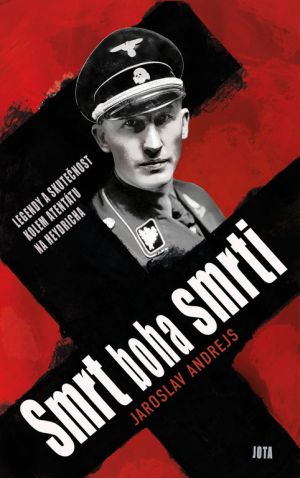
English version
Against the backdrop of the 80th anniversary of the removal of Reinhard Heydrich, a very elaborate history of events connected to this brave act under the title Death of the God of Death is published in the edition of Literature of Fact and Military of well-known publishing house Jota at Brno, Czech Republic. The author is Jaroslav Andrejs, who, as a living participant in the events of 1942, wrote the book Behind Heydrich Shadow in 1947, in which he was the first to attempt to summarize and explain to the public the history of the background and the course of the action leading to the death of Reinhard Heydrich.
This Nazi executioner of not only the Czech nation became a kind of idée fixe, which the author presented with his own thoroughness and in a very comprehensible way in another more comprehensive treatment of these historical events, which interfere with a significant work not only in the history of the Czech anti-fascist resistance, but also in the personal lives of many protagonists. The author's book debut was a memoir under the title In Our Young Years as early as 1943.
However, let's return to the content and execution of the reviewed work. Personal knowledge of the environment, actors and period realms, together with a perfect literary form of narrative, makes this work not only a kind of continuation of the 1947 book, but a perfect analysis of the motives and circumstances of the realization of persons and organizations of the Protectorate era as well as an appealing quasi-roman shaped as a uniquely and engagingly formulated overview of almost all significant gun lines, however connected in the sequence of events resulting in the successful killing of one of the leading representatives of the security apparatus of Nazi Germany under Adolf Hitler. Factology does not diminish the literary value of this work, on the contrary. The work itself was already perfectly readable in the first book version from 1947, and the topic drew into the ranks of readers many people, who until then had only the propaganda of the warring parties and the stark facts of the coverage of that era.
The action itself was evaluated by numerous experts already during the war as one of the most significant acts expressing the resistance of Czechoslovak citizens from occupied countries to the German Reich and the tripled creation of the Protectorate of Bohemia and Moravia as such.
The author's perfectly expressed ability to evoke the gloomy atmosphere of occupation and Protectorate, certainly reinforced by his personal experiences, was during the elapsed time since the author's first book treatment of this topic, refined into a new use of many available archival materials, personal memories and literary experiences of a proficient middle-aged author. By collaborating with the persons named in the Author's thanks mentioned before the Preface to the book, the whole work was noticeably enriched and I am not afraid to say that in this respect there is not another book on our book market that is so readable and yet historically accurate. This attractive topic has been elaborated many times in the form of a book, film and theatre, that it is a great honor to a number of critics, who mostly approvingly deal with Andrejs's work.
The use of the form of direct quotation of conversations taking place in the environment of both Nazi leaders and between their individual opponents is based not only on the occasional author's learned fiction, but roughly equally, as mentioned above, on the perfect personal knowledge of the realities and persons involved in the story line at various positions and their connection with hitherto unpublished archival materials.
The personal morally free qualities of the actors in many ways condition the course of events sometimes to a totally unexpected manner and scope – and it was this part of the history line that the author was able to perfectly portray. The treatment of written reflections and actual events affects the reader in its entirety in such a way that he can almost immediately be drawn by his thoughts into the ongoing action, allowing him not only to feel it through an almost personal experience, but also to often understand the motives of the participants, even those often thoroughly hidden and in their consequences all the more dangerous.
Whoever discovers in the author's work a novel, full of factography and psychological considerations, elaborated by an experienced literary hand, is not mistaken. After all, the boundaries of the genres of the literature of fact and of the novel are sometimes perfectly blurred and intertwined. It is not always to the detriment of the thing, as this book shows. Whoever deals with anything from the history of the Second World War will certainly find passages in it that will fascinate him perfectly and, I dare say, often surprise him.
The book has a third edition, 383 pages and 24 pages of period photographed appendices, and a Conclusion that summarizes the events and highlights some of the circumstances of the action of particular importance as well as the persons who acted on its course with the greatest, even catastrophic, consequences.
The book's subtitle is: The Legends and the Facts surrounding the assassination of Heydrich. This is the most concise summary of the book's content, which is sure to interest a wide circle of readers as much or more as it intrigued me personally.